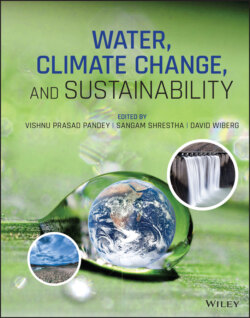Читать книгу Water, Climate Change, and Sustainability - Группа авторов - Страница 24
2.1. INTRODUCTION
ОглавлениеThe United Nations’ (UN) 2030 Sustainable Development Agenda agreed by the member countries marks the beginning of a new era and a true beacon of hope for the sustainable development. An important feature of this agreement was the launching of 17 sustainable development goals (SDGs), spread across 169 targets and over 230 indicators, encompassing the major sustainable development agenda of modern times. SDGs – also known as “Global Goals “ signifying their global scope – provide a visionary roadmap or a guide for all countries, governments, and stakeholders to strive for sustainable development in every aspect of decision‐making while addressing some of the most pressing challenges facing humanity (ICSU 2017). SDGs are transformative provided their effective implementation takes place at all levels, that is local, sub‐national, national, and international levels.
Water has a dedicated goal (Goal #6) to “ensure availability and sustainable management of water and sanitation for all” in SDGs. Water is at the core of SDGs and acts as an enabler for realizing the 2030 Sustainable Development Agenda. Water security underpins sustainable development as it shares a close interdependency with multiple sustainability challenges such as in terms of food security, economic development, energy generation, environmental sustainability, and climate change.
Implementation of SDG 6 along with other targets of 16 SDGs is an overwhelming task for many developing countries, where the means of implementation (MOI) and capacity to mobilize resources are limited. Equally important are cross‐linkages between SDG6 and other SDGs such as water related disaster (Goal 11), zero hunger (Goal 2), good health and well‐being (Goal 3), climate action (Goal 13), etc. Because of these inter‐linkages, implementation of each SDG could complement or contradict the outcomes of other SDGs. There are calls for pursuing an integrated approach for implementing SDGs so that synergies could be maximized while warding off unintended outcomes.
Need for an integrated way of thinking is critical while implementing water related targets. An integrated approach to the implementation of SDG6 would significantly boost the opportunities for achieving long‐term sustainable development. However, an integrated vision is lacking for implementing water related SDGs, including the Goal 6, despite the fact that there is a long history, scientific backing, and repeated calls to pursue a coordinated water resources management. Since SDG6 was built on Millennium Development Goals (MDGs) target on drinking water and sanitation (7c), interpretation of the goal is still skewed towards drinking water and sanitation (Targets 6.1 and 6.2). In fact, it is estimated that 2.2 billion people still lack access to safely managed drinking water services and staggering 4.2 billion people lack safely managed sanitation services (UN‐Water 2019). For the achievement of SDG6 and to realize the vision of 2030 Sustainable Development Agenda, addressing the fundamental human rights to safe drinking water and sanitation is indispensable. From that viewpoint, SDG6 could be viewed an expansion of MDG 7.c to accommodate the shortcomings in the indicators for safe water and basic sanitation (Weststrate, et al. 2019).
It is quite imperative that the implementation of the SDG6 and other water relevant targets have to build upon the progress made on water resource management as well as on the achievements of MDG, in particular, the target on drinking water and sanitation (Target 7.c). Beyond drinking water and sanitation, it is also equally important to balance weightage on the rest of the water related targets, which are yet to draw enough traction. A paradigm shift is needed to recognize that Goal6 targets are wider in scope, highly interdependent, and will require considerably more effort to achieve (UN‐Water 2016b).
There are calls to revitalize the role of integrated water resource management (IWRM) to implement SDGs, while Target 6.5 stresses the implementation of IWRM at all levels (Smith and Clausen 2018). While criticisms on MDG 7.c regarding the need for IWRM are covered or complemented by Target 6.4, 6.5 and 6.6 (Weststrate, et al. 2019), it is hard to conclude if IWRM could be viewed as a means to co‐achieve SDG6 targets or an end to assess the effectiveness of implementation of the goal or both.
The objective of this chapter is to critically assess the relevancy of pursuing an integrated approach for implementing SDG6 and other water‐relevant targets. This chapter argues that promoting a basin‐wide collaborative mechanism could be an effective entry point not only for sustainable water resource management but also for generating synergistic outcomes across multiple targets of SDGs. It takes an example of the Lower Mekong Basin to examine the complexities, opportunities, and potential way forwards for a river basin approach for implementing SDG6 along with other water related targets of SDGs.
